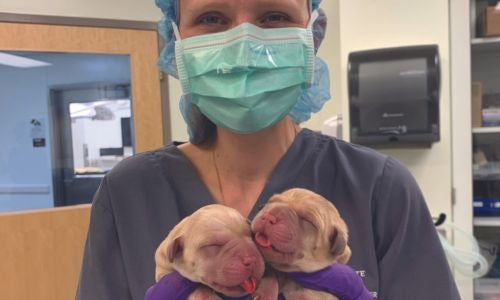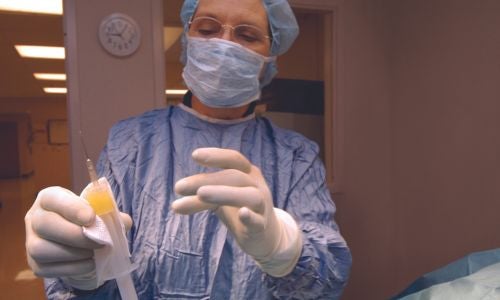Taking The Guesswork Out of Dog Breeding with Progesterone Testing

Accuracy in timing a dog breeding using progesterone testing can help achieve efficiencies in litter production. In other words, knowing the right time to breed a female in estrus, or in heat, is a cornerstone of good breeding management.
“Progesterone increases in a predictive manner, so we can use it to determine the important landmarks for breeding, such as the LH surge, ovulation and the fertile window,” says Gail McRae, DVM, who is completing a theriogenology residency at The Ohio State University College of Veterinary Medicine. She presented on progesterone testing at the AKC Breeder Symposium last fall in Columbus, Ohio.
A reproductive hormone, progesterone, increases in the female’s blood prior to ovulation. As the progesterone level increases, another hormone, luteinizing hormone (LH), is released from the pituitary gland, stimulating the release of eggs from the follicles and triggering ovulation and the further rise in progesterone. The eggs mature in around 48 to 72 hours and thus become ready to be fertilized by sperm.
“Progesterone is the only way we truly know when a female is ready to be bred. It also helps narrow down the whelping date to 63 days plus or minus one day from ovulation or 65 days plus or minus one day from the LH surge,” explains Dr. McRae who is also completing a master’s degree in which she is studying infertility in females.

Breeders may opt to work with reproduction specialists who are boarded in theriogenology or veterinarians with a special interest in reproduction for best practices in dog breeding. Particularly when using frozen semen veterinary reproduction specialists can help determine the ideal time to breed for best outcomes.
“The semen type dictates the right time to breed. Fresh semen on average lasts over 48 hours, chilled semen lasts about 48 hours, and frozen semen lasts 12 to 24 hours. If we are doing a frozen semen breeding, we usually wait until day three or four post-ovulation to breed a female to ensure the eggs are mature. We want the progesterone level to be around 15 nanograms per milliliter in the blood,” Dr. McRae says.
“If we are using fresh or chilled semen, then we breed during post-ovulation on days one and three or on days two and four. We also can breed one time on days two to three post-ovulation for best results. This is because the sperm is viable for five to seven days and because it takes the eggs around two days to mature prior to fertilization. The rate of maturation of the eggs differs based on the amount of progesterone present.”
At Ohio State, the theriogenology team uses an Immulite machine to determine the progesterone level in females. The two-hour Immulite progesterone test relies on a method called chemilumenescence to pick up the presence of certain enzymes and provide a quantitative level of progesterone.
“We recommend that breeders work with their veterinarian and have their blood samples sent out to a diagnostic testing laboratory to be tested on an Immulite machine to ensure accurate, comparable results,” Dr. McRae says. “Although there are many different progesterone-testing machines, some may only be reliable in the lower progesterone numbers, not when progesterone reaches the higher numbers that are so important when we are doing frozen semen or artificial insemination breedings.”

Breeders typically have progesterone testing per-formed every two to three days starting five to seven days into the heat cycle. The cost of progesterone testing varies according to individual veterinary clinics and geographical location but averages around $100 to $120 per test. Four to seven progesterone tests are common per breeding cycle.
Veterinarians also may use vaginal cytology to help determine a female’s stage of the heat cycle. Examination of the degree of epithelial cell cornification, a process in which cells lose their nuclei and flatten out, can determine whether a female is in or out of season. Rising levels of the hormone estrogen cause the vaginal epithelium to become cornified.
“Vaginal cytology is an extremely useful tool for a veterinarian to use,” Dr. McRae says. “The changes we see during estrus are from the rise in estrogen. When we see lots of cornified cells, over 95 percent, the female is in estrus. If we think she is near the end of the fertile window, we can use vaginal cytology to see if she is still in heat. If we see 40 to 60 percent cornified cells with some white blood cells, this could indicate that we have missed the fertile window for breeding, though this also could indicate she is in proestrus and is too early to be bred.
“A progesterone test taken at the same time as vaginal cytology will confirm whether she is going out of heat, or in diestrus, and thus too late to breed, or still very early, or in proestrus. If progesterone is low, this correlates with proestrus, and if progesterone is high, this correlates with diestrus.”
The value of using progesterone testing to plan and time a breeding is immeasurable.
“If an owner is doing natural breedings and not having success, progesterone testing can be done to help nail down the timing better,” Dr. McRae says.
“We recommend doing progesterone testing on females that may need a cesarean section, as this provides a three-day window for the due date if we can know when she had her LH surge and ovulated. When an important breeding using frozen semen is planned, we highly recommend using progesterone testing to ensure the best opportunity for success.
“Progesterone testing is another tool in our toolbox that takes the guesswork out of breeding.”
Tools To Determine Ovulation
Veterinarians who specialize in reproduction often use a toolbox approach that include the following diagnostics to determine the appropriate time to breed.
-
Hormonal testing, such as progesterone and luteinizing hormone (LH) assays, indicates the presence and/or the amount of reproduction hormone in the blood. A surge of LH stimulates the release of eggs, which contributes to the rise in progesterone in the bloodstream just prior to ovulation in the female.
-
Vaginal cytology determines if the female is in season (estrus) or out of season (diestrus) via examination of the degree of epithelial cell cornification, a process in which cells lose their nuclei and flatten out. Veterinarians often per-form vaginal cytology on days when breedings are planned to confirm that a female is still in her fertile window.
-
Vaginoscopy using an endoscope is particularly helpful when transcervical artificial insemination is performed, as it provides a view of the vaginal epithelium that helps to determine the fertility peak. The appearance of the vaginal epithelium is crenulated, or has a wavy outline, during the period of optimal fertility.